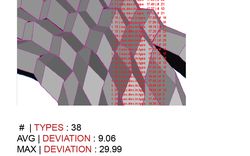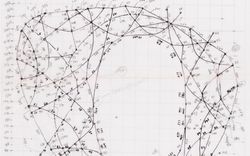Embryological House
Text by Howard Shubert
The dynamic forms of the Embryological House (1997–2001) comprise flowing and vector-based surfaces, sometimes referred to as “blob” architecture, made possible through animation software.
Through the Embryological House Lynn rethinks the notion of the manufactured house, moving from the modernist idea of a form based on modules to a form based on potentially unlimited iterations derived from a basic form, or “primitive.” His goal is to design and manufacture houses that exhibit variety based on shared regulating principals—a “mass customization” to allow the mass production of individually unique products. Lynn expects the new capabilities of computer-aided design and computer-numerically-controlled (CNC) manufacturing to support this kind of design process.
Lynn first established the parameters for the Embryological House geometry (the primitive curves) using Microstation software. By experimenting with a series of twelve control points attached to this basic geometry he established prescribed limits, beyond which impractical designs would result.
The resulting geometrical files were then imported to Maya, a software notable for its three-dimensional blending capabilities. Maya enabled Lynn to produce the kind of smoothly rendered surfaces that he admires in the automotive and aeronautic industries.
Physical models for the Embryological House were produced using prototyping technology in order to test the design’s compatibility with available manufacturing technology. The materiality of his models formed an important part of the creative process. For example, Lynn deliberately exposed the means of manufacture by allowing the computer-controlled tools to leave their marks on the models’ surfaces.
Models made using light-sensitive stereolithography resin or ABS plastic from milled MDF wood moulds were produced by the dozen. Referred to by Lynn as “eggs,” the ABS plastic models were produced in three sizes, “A,” “B” and “C,” further reinforcing the association with supermarket eggs. Like the store-bought variety, no two Lynn eggs are alike yet all bear a family resemblance to each other and to the “primitive” from which they derive. Producing his egg models in multiples also enabled Lynn to suggest the iterative and virtually unlimited potential underlying his approach to the Embryological House.
In our collection, we have over one hundred physical Embryological House models produced in a variety of materials, as well as the complete digital record of the design development and presentation of the project.


















